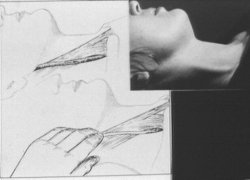[Skill Modules
>>
Neck & Veins Examination
>>
Techniques
]
Techniques: Jugular Venous Pressure Measurement (JVP)
The technique for examination for CVP (central venous pressure)
- Patient reclining with head elevated 45 °
- Measure elevation of neck veins above the sternal angle (Lewis Method).
- Add 5 cm to measurement since right atrium is 5 cm below the sternal angle.
Normal CVP <= 8 cm H2O
- Light should be tangential to illuminate highlights and shadows.
- Neck should not be sharply flexed.
- Using a centimeter ruler, measure the vertical distance between the angle of Louis (manubrio sternal joint) and the highest level of jugular vein pulsation. A straight edge intersecting the ruler at a right angle may be helpful.
Note: Ability to measure jugular venous pressure will be difficult if pulse is >100 per minute.

Cardiovascular Resources Videodisc
- If the internal jugular vein is not detectable, use the external jugular vein. The internal jugular vein is the preferred site.
back to top
Distinguishing the internal jugular vein pulsations from the carotid artery

| Jugular Vein |
Carotid Artery |
| No pulsations palpable. |
Palpable pulsations. |
| Pulsations obliterated by pressure above the clavicle. |
Pulsations not obliterated by pressure above the clavicle. |
| Level of pulse wave decreased on inspiration; increased on expiration. |
No effects of respiration on pulse. |
| Usually two pulsations per systole (x and y descents). |
One pulsation per systole. |
| Prominent descents. |
Descents not prominent. |
| Pulsations sometimes more prominent with abdominal pressure. |
No effect of abdominal pressure on pulsations. |
Proceed to the next technique
|

